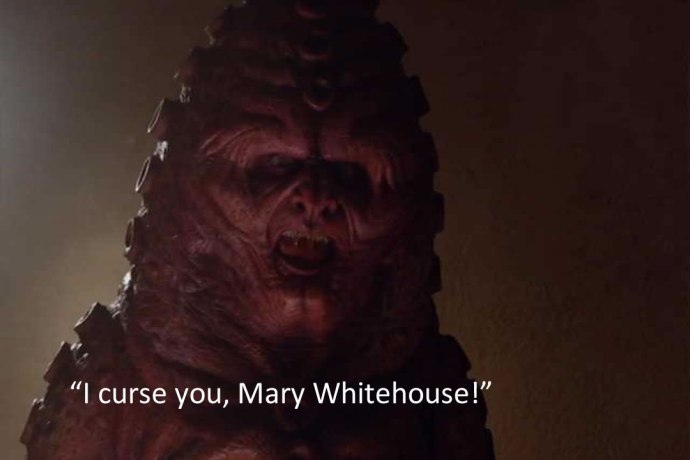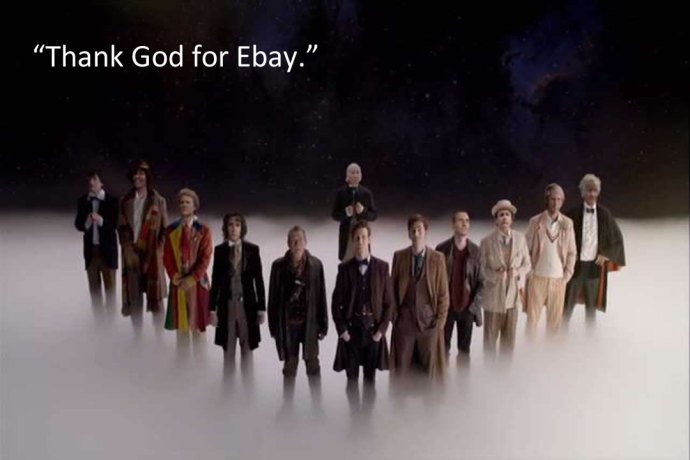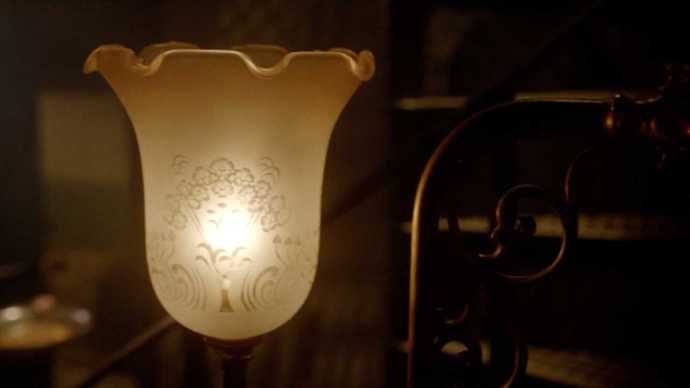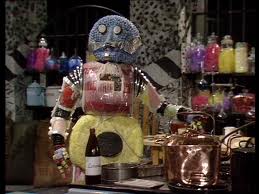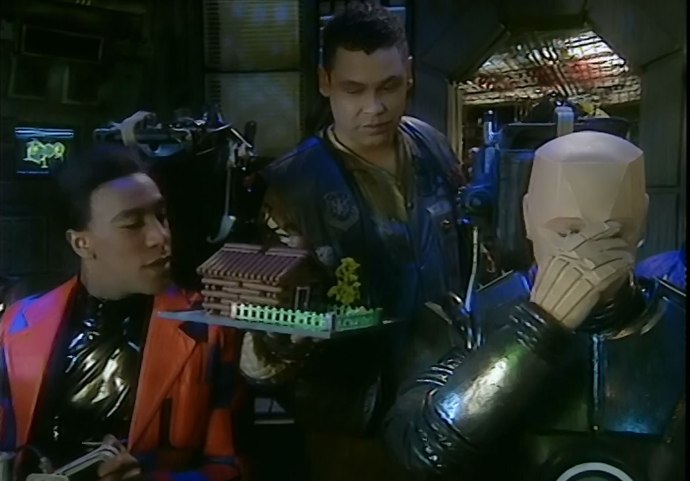I was teasing the boys on Saturday. “Of course, the Doctor might regenerate,” I said, knowing he wouldn’t. “We might see the Twelfth Doctor.” Thomas then proceeded to ask what he looked like, and of course I didn’t know. After lunch, he fetched the customisable sonic screwdriver set that Emily got me for Christmas and assembled his own version, calling it “the Twelfth Doctor’s sonic screwdriver, and I’m the Twelfth Doctor”. I nodded and smiled and took his photo, whilst working out what I’d say to him when it got to the end of the evening with no sign of a new Doctor.
Then we saw the episode.
The appearance of John Hurt – who, I confess, I’d entirely forgotten was going to appear – threw in a complete curveball at the very end. It wasn’t so much a cliffhanger as a game-changer, a reassessment of who the Doctor was and how we got here. It was also a shameless bit of stunt-casting. It was the First Doctor before he took on the appearance of Hartnell. It was an obvious reference to the Time War. It was the Other before he threw himself into the Looms. It was the final Doctor, who will not live to regenerate. It was brilliant. It was terrible. It was all of the above and none of the above, depending on what you read and what you want to believe. I think we’re beyond the stage now where it matters. This has either been the worst series since the revival or a dazzling return to form, and if you’re on one side then nothing the other can say is going to influence you. Perhaps we should stop arguing about it, stop polluting the pages of the web with our ramblings, and accept that we see things differently.
But this will fall on deaf ears. The enigma of Hurt’s Doctor and who he is will be shoved back and forth across blogs, Facebook groups, sycophantic Dan Martin Guardian columns, bitch-fests from Lawrence Miles and rambling fan videos from incoherent YouTube pundits, and it will long outlast its expected sell-by date. We’re all going to be horribly sick of it by November, and it’ll lead to a glorious anti-climax where you’ll be told something crushingly disappointing. Because ultimately, that’s what Moffat does. He asks you to guess what he’s thinking, but these days it’s seldom interesting or satisfying.

If nothing else, the “bit with Doctor Hurt” (as Thomas referred to it) puts an older actor in the role – something I’ve longed for, and something we’ve not had since Pertwee, who took over the role at 51. Of course, Pertwee embodied a dynamic, action-driven side to the Doctor, gleefully bringing down foes with skilfully choreographed martial arts courtesy of the stunt directors. It was something capitalised on by the relatively youthful Baker when he adopted the role some four years later, to the extent that the dashing sidekick who’d been brought in to do all the stunts was written out after several stories, having been used mostly to provide bumbling comic relief with occasional moments of brilliance. Still, the physical, action-orientated stance of the new incarnation of the programme has prevented the BBC from casting anyone who’s likely to get a heart attack from running along a corridor in a disused steelworks being chased by a monster that isn’t there.
This has meant a spate of younger Doctors; a trend that looks set to continue. Because let’s be clear on this: Hurt’s casting is atypical in that whoever it is, it is not a Doctor who is going to stay the course. He hasn’t said more than two dozen words yet and already we have established that he is a Doctor who either should not exist, a wibbly wobbly anomaly, or an incarnation who has been assigned to a crumbly CG-generated hell (filmed on location in urban Glasgow) because he did or will do something terrible. He is the Doctor’s dirty little secret, along with his secret stash of Sontaran pornography and what he and River really get up to with those handcuffs. (I suspect these two things probably aren’t mutually exclusive. There, that’s put images in your head, hasn’t it?)

It’s a shame that in establishing this fact, Moffat resorted to the laziest, lamest trick in the writer’s book, which is to end an episode (and indeed a series) with that episode’s title. Some weeks ago, Gareth suggested to me that there would be a feint of some sort and that you’d have a bunch of characters charging into battle, dying in slow motion, bellowing “IN THE NAME OF THE DOCTOR!”. He was joking, but that’s only slightly more silly than what actually happened. I was so busy reeling from this that I didn’t even notice that Moffat also fulfilled Dorium’s “Fall of the Eleventh” prophecy by having the Doctor say “We don’t jump; we fall”.
I mean, honestly. This isn’t a clever reversal. It’s just bad writing. Confounding the expectations of your audience by deflating the balloon because it’s the last thing they were expecting is inexcusable. Making a joke out of a foreshadowing comment that is supposed to allude to the Doctor’s death doesn’t make you look clever or a master of your craft. It makes you look like a smug drama student. It’s like Bilbo Baggins getting Gollum to guess what’s in his pocket – a riddle he asked by accident and then exploited to get out of a life-or-death situation, but to the best of my knowledge no one is approaching Moffat across a slimy rock, threatening to eat him if he can’t guess what’s alive without breath and cold as death.

I remember being eight years old, and sitting at the side of the school field playing I Spy with a couple of friends. They tried, for a good two or three minutes, to guess the ‘B’ I said I’d seen, and eventually gave up, pronouncing me the winner. “Bus,” I said. “I saw one go past a while ago.” It’s cheating, and it’s unfair. But it was technically accurate. And thus it was a plot twist in the story of the game, one that eerily echoed the style of our current chief writer. Which is why the endless praise and shouts of “brilliant” baffle me.
“Yesterday,” said Gareth, “I gave a brief summary of the bits I knew of the episode. Try it, and about halfway through you’ll find yourself thinking ‘This is just really bad fanfic – if anyone had written it last year it would have been ridiculed’.” And he’s right. It reads like bad fanfiction and Moffat gets away with it because we still know him as the writer of ‘The Girl in the Fireplace’ and we cannot quite wrench ourselves away from that image, or from the fact that a man capable of brilliance simply isn’t suited to a role like this.

Of course, the question of who the Doctor is turned out fairly early on to be fundamentally unimportant, when the words “It is discovered” turned out not to allude to the Doctor’s name at all, but rather the location of his grave. This needn’t mean that the end of the show is in sight. An eventual death does not mean an imminent death, and there was no sign of any corpse inside the Trenzelore TARDIS. One could, perhaps, nitpick over the fact that the interior echoes the current design, but in the grand scheme of things I think there are other aspects upon which I could waste my time. Like the rotten dialogue, or the fact that the design of the Whispermen was strangely familiar.

Certainly there were good things this week. When the Doctor is informed that his friends have been taken to Trenzelore, his reaction is to sit down on the sofa and burst into tears. It’s a mesmerising performance from Smith, so easy to forget in the blustery of what follows, but it’s arguably the most upset we’ve seen the Doctor since the revival of the show – a frail, fragile moment, and I wish we’d had a little more of that, and less of the angst-ridden silliness that followed.

In all seriousness, this was good.
Performances aside, Saul Metzstein directed this as well as he’s directed any of his other episodes, with the darkness of Trenzelore effectively realised in the few shots we saw of it. This seemed to be a finale that dealt with metaphysics as much as anything else, and as such sets were almost theatrically abstract, with atmospheric, moody lighting standing in for actual detail. This was an episode of dread, and Metzstein (and cinematographer Neville Kidd) evoked this by juxtaposing tight, claustrophobic shots with wide, angled ones, as if someone were being observed from not far off.


Similarly, the opening montage showed a certain visual panache, particularly if you didn’t know it was coming – as I didn’t. It was rough around the edges, for sure. The limitations of the BBC’s effects budget showed when Jenna-Louise Coleman was digitally pasted into old footage, standing looking confused in a park while someone who looks absolutely nothing like Patrick Troughton runs past her. But elsewhere, it worked. The tints and grains came out again as Clara jumped through different eras and went through costume changes at a rate that rivalled that of Madonna in Evita. This included a questionable CG-driven appearance from Jon Pertwee, and blink-and-you’ll-miss-it encounters with the Eighth and Ninth. Davison was seen lying on a floor, presumably spouting dialogue from what I thought was ‘The Caves of Androzani’ (but which Gareth insists is probably from the beginning of his run), and Clara appeared to linger in the same corridor they used in ‘Journey to the Centre of the TARDIS’ as a tall man in the Sixth Doctor’s frock coat and a blonde wig wanders past. (Presumably it was Sylvester McCoy.)


The fans’ reaction to this opening, I’m told, has been split: a mixture of yah-boo-sucks directed at the naysayers, while the cynical amongst us have pointed out that it was mostly a lot of smoke and mirrors. Still, it looked reasonably impressive, and there was one moment of apparent importance, with an eyebrow-raising encounter back on Gallifrey. Fans of ‘The Doctor’s Wife’ will recall that the Doctor did not steal the TARDIS; the TARDIS stole him. This always felt like unnecessary anthropomorphism to me – the sort of thing that people say about their cats when it simply isn’t true – but it was in this singular scene that the police box’s apparent love-hate relationship with Clara was reconciled: through Clara, the TARDIS is able to reach out to the Doctor and influence him. Clara thus becomes the equivalent of a surrogate, with all the complications that that relationship entails. And it’s still silly, because it doesn’t seem to fit. (“I thought from what I read,” said Gareth, “that her meeting the Doctor was trying to save him from the Great Intelligence’s interference somehow. Was the GI whispering ‘go on, take this TARDIS – it comes with its own baby dinosaur’?”.)
While we’re on that, it’s also worth bearing in mind, of course, that the entire falling through time sequence was built on a colossal and quite unnecessarily complicated plotline: that of (the again under-used) Richard E Grant entering the Doctor’s time stream and changing everything he’s ever done. I know that time is supposed to be a non-linear ball of wibbly-wobbly timey-wimey stuff (I have left out the pause, but it was there) – nonetheless, wouldn’t it have made more sense for Grant to go back and kill the Doctor outright before he stole the TARDIS, while he was a frail and feeble old man, and save himself the trouble of having to dimension hop for millennia? But that would have been far too simple, and instead we’re faced with the supposedly Great Intelligence jumping through time, changing history for the worse, with Clara in hot pursuit, striving to put right what once went wrong. It’s like watching five series of Quantum Leap over the course of a few seconds, and we didn’t even get to see Dean Stockwell in a red suit.

And while I’m complaining, I would like to point out that River Song’s appearance in this was nothing short of a disaster. It’s not that Moffat can’t write love stories. He proved that he could with ‘Blink’ and ‘The Girl in the Fireplace’, both of whom have touching, unresolved matters of the heart at their core. But the love scenes with River are turgid and unconvincing and riddled with shocking dialogue (I feel a top ten coming on, but I’ll leave that for another day when I don’t feel quite so cross). See for example:
River: There has to be another way. Use the TARDIS. Use something! Save her, yes, but for God’s sake, be sensible! [She goes to slap him and he catches her wrist] How are you even doing that? I’m not really here.
The Doctor: You’re always here to me. And I always listen. And I can always see you.
River: Then why didn’t you speak to me?
The Doctor: Because I thought it would hurt too much.
River: I believe I could have coped.
The Doctor: No. I thought it would hurt me. And I was right.
How, exactly, are we supposed to cope when confronted with this drivel? It doesn’t help that there’s no chemistry at all between Smith and Kingston, but even Elizabeth Taylor and Richard Burton couldn’t polish a turd. Still, we can’t just blame the dialogue – it’s the whole setup. The other part of the problem, you see, is the nature of the Doctor having any sort of lover, simply because it sexualises him and calls to mind the question of what he’s like in bed. It’s an elephant in the room, but that’s what you were all thinking about during that kiss, wasn’t it?

But there was, again, that feeling of smoke and mirrors during the finale: the sense of a beginning, and not an ending. Moffat has a tendency to open up a new mystery just as he’s resolving an older one, and while we now understand the mystery of Clara and no longer care about the identity of the Doctor, another enigma has cropped up to take its place. I wouldn’t mind this, except that some three years later, I’m still not entirely clear on how or why the TARDIS exploded.

This feels very much like the chief writer stretching out his run on the show to breaking point, and serving up mystery after mystery purely as a guarantee that they will extend his contract, until he can resolve that story arc and start up a new one at the end of the series. Seldom is there any real closure, the way there was even under Davies’ reign, because there is always a new puzzle to be debated and blogged. It’s a trick used in 24, which got away with it (just) on the grounds of being a show that was outlandishly silly. But Doctor Who is not supposed to be silly. It frequently is, and occasionally on purpose, but I seriously doubt that they sit down at tone meetings and say “Right: zany, off-the-wall looniness for that Dalek story, then”. It’s supposed to be a flagship of British family entertainment. It is a show that contains amusing moments and the occasional subtle fracturing of the fourth wall (mostly through a mockery of writer’s conventions that I will grant is done quite well), but it’s taken very seriously by everyone who produces it. Every episode is supposedly lovingly crafted to respect what has gone before and then build upon it for the future.
And maybe that’s the problem. Maybe we expect the show to look too much to the past. Perhaps Davies’ first series in charge was overlooked. For better or worse, he rewrote the rule book and appeared to have little, if any consideration for what had happened before, inventing new monsters galore and cutting all ties with the Time Lords and Gallifrey with a view to building up a new fanbase from the ground up. At the time, we called this disrespectful. We called it dumbing down, and not mindful of the legacy of the programme and its perennial viewers. And then everything changed. Some eight years later, we have a show that is so steeped in its own sense of history and self-importance it has become its own Episode 1: tired, humourless, and far too pompous to actually achieve its aims. Doctor Who is struggling with the millstone of history that is affixed round its neck – racing back and forth through its own history, too concerned with continuity to think about story. It has become the Doctor himself, in that final sequence, submerged and suffocated and seemingly entrapped within his own timeline. We wanted more respect for tradition, and we got it, but the price tag was heavy – and if we may take anything from Saturday evening, and this series in general, it’s that you should be careful what you wish for.
























